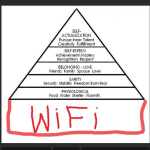lpetrich
Contributor
Around World War II, psychologist Abraham Maslow decided to consider mentally healthy people, to balance out study of mental pathologies. In 1943, he published his conclusions in "A Theory of Human Motivation" in Psychological Review.
He proposed that we have a hierarchy of needs, from the physiological to the transcendent.
 Maslow's hierarchy of needs, Maslow's Hierarchy of Needs | Simply Psychology, Abraham Maslow and Happiness, What Is Maslow's Needs Hierarchy?
Maslow's hierarchy of needs, Maslow's Hierarchy of Needs | Simply Psychology, Abraham Maslow and Happiness, What Is Maslow's Needs Hierarchy?
This is often depicted as layers of a pyramid. From bottom to top:
They can be classified further:
The Simply Psychology article has another version of it.
In 1970, AM studied 15 people that he considered self-actualized, and here is what he concluded about them.
Characteristics of self-actualizers:
1. They perceive reality efficiently and can tolerate uncertainty;
2. Accept themselves and others for what they are;
3. Spontaneous in thought and action;
4. Problem-centered (not self-centered);
5. Unusual sense of humor;
6. Able to look at life objectively;
7. Highly creative;
8. Resistant to enculturation, but not purposely unconventional;
9. Concerned for the welfare of humanity;
10. Capable of deep appreciation of basic life-experience;
11. Establish deep satisfying interpersonal relationships with a few people;
12. Peak experiences;
13. Need for privacy;
14. Democratic attitudes;
15. Strong moral/ethical standards.
Behavior leading to self-actualization:
(a) Experiencing life like a child, with full absorption and concentration;
(b) Trying new things instead of sticking to safe paths;
(c) Listening to your own feelings in evaluating experiences instead of the voice of tradition, authority or the majority;
(d) Avoiding pretense ('game playing') and being honest;
(e) Being prepared to be unpopular if your views do not coincide with those of the majority;
(f) Taking responsibility and working hard;
(g) Trying to identify your defenses and having the courage to give them up.
Looking at the Big Five personality traits, this would seem to be Openness high, Conscientiousness high, Extroversion not very high, Agreeableness moderate (between grumpy and being a doormat), and Neuroticism not very high.
AM seemed to think that one has to succeed at each level before moving on to the next level, and that's gotten a lot of criticism. But IMO his hierarchy is a good way of sorting out the things that we desire.
He proposed that we have a hierarchy of needs, from the physiological to the transcendent.
This is often depicted as layers of a pyramid. From bottom to top:
- Physiological: breathing, food, water, sex, sleep, homeostasis, excretion
- Safety: security of body, employment, resources, morality, family, health, property
- Love and Belonging: friendship, family, sexual intimacy
- Esteem: self-esteem, confidence, achievement, respect of others, respect by others
- Self-actualization: morality, creativity, spontaneity, problem solving, lack of prejudice, acceptance of facts
They can be classified further:
- Deficiency or D-needs:
- Basic needs: 1, 2
- Psychological needs: 3, 4
- Growth or being or B-needs:
- Self-fulfillment needs: 5
The Simply Psychology article has another version of it.
- Biological and Physiological needs - air, food, drink, shelter, warmth, sex, sleep, etc.
- Safety needs - protection from elements, security, order, law, stability, etc.
- Love and belongingness needs - friendship, intimacy, trust and acceptance, receiving and giving affection and love. Affiliating, being part of a group (family, friends, work).
- Esteem needs - self-esteem, achievement, mastery, independence, status, dominance, prestige, managerial responsibility, etc.
- Cognitive needs - knowledge and understanding, curiosity, exploration, need for meaning and predictability.
- Aesthetic needs - appreciation and search for beauty, balance, form, etc.
- Self-Actualization needs - realizing personal potential, self-fulfillment, seeking personal growth and peak experiences.
- Transcendence needs - helping others to achieve self actualization.
In 1970, AM studied 15 people that he considered self-actualized, and here is what he concluded about them.
Characteristics of self-actualizers:
1. They perceive reality efficiently and can tolerate uncertainty;
2. Accept themselves and others for what they are;
3. Spontaneous in thought and action;
4. Problem-centered (not self-centered);
5. Unusual sense of humor;
6. Able to look at life objectively;
7. Highly creative;
8. Resistant to enculturation, but not purposely unconventional;
9. Concerned for the welfare of humanity;
10. Capable of deep appreciation of basic life-experience;
11. Establish deep satisfying interpersonal relationships with a few people;
12. Peak experiences;
13. Need for privacy;
14. Democratic attitudes;
15. Strong moral/ethical standards.
Behavior leading to self-actualization:
(a) Experiencing life like a child, with full absorption and concentration;
(b) Trying new things instead of sticking to safe paths;
(c) Listening to your own feelings in evaluating experiences instead of the voice of tradition, authority or the majority;
(d) Avoiding pretense ('game playing') and being honest;
(e) Being prepared to be unpopular if your views do not coincide with those of the majority;
(f) Taking responsibility and working hard;
(g) Trying to identify your defenses and having the courage to give them up.
Looking at the Big Five personality traits, this would seem to be Openness high, Conscientiousness high, Extroversion not very high, Agreeableness moderate (between grumpy and being a doormat), and Neuroticism not very high.
AM seemed to think that one has to succeed at each level before moving on to the next level, and that's gotten a lot of criticism. But IMO his hierarchy is a good way of sorting out the things that we desire.

